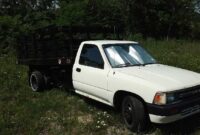1970s Chevy Pickup Trucks For Sale: A Comprehensive Buyer’s Guide pickup.truckstrend.com
The 1970s, a decade defined by cultural shifts and automotive innovation, also gave birth to a line of trucks that would become legendary: the Chevrolet "Square Body" pickups. Produced from 1973 to 1987, these trucks, particularly those from the 70s, have transcended mere utility to become coveted classic vehicles. Their rugged good looks, straightforward mechanicals, and undeniable nostalgia factor make them incredibly appealing to collectors, restorers, and everyday enthusiasts alike. If you’re considering a 1970s Chevy pickup for sale, you’re not just buying a vehicle; you’re investing in a piece of automotive history that offers both timeless style and practical versatility. This comprehensive guide will navigate you through the world of 70s Chevy trucks, helping you find your perfect Square Body.
The Enduring Appeal of the Square Body Generation
1970s Chevy Pickup Trucks For Sale: A Comprehensive Buyer’s Guide
The third generation of Chevrolet C/K series trucks, affectionately known as the "Square Body," represented a significant departure from their predecessors. Launched in 1973, these trucks boasted a more modern, aerodynamic design (for their time), improved comfort, and a wider range of engine and trim options. Their angular lines, prominent grille, and robust stance give them an unmistakable presence that continues to turn heads today.
What truly defines their enduring appeal is a blend of factors:
- Iconic Design: The clean, purposeful lines have aged incredibly well, making them instantly recognizable and stylish.
- Mechanical Simplicity: Unlike modern vehicles, 70s Chevys are relatively straightforward to work on, making them popular among DIY mechanics and reducing repair costs.
- Robust Construction: These trucks were built to last, with sturdy frames and durable powertrains.
- Versatility: From workhorse utility to customized show truck, the Square Body can adapt to almost any role.
- Nostalgia: For many, these trucks evoke memories of a simpler time, making them a powerful link to the past.

Throughout the 1970s, Chevrolet offered a variety of configurations within the C/K series:
- C-Series: Two-wheel drive (2WD) models, ranging from light-duty C10s (1/2 ton) to heavy-duty C30s (1 ton).
- K-Series: Four-wheel drive (4WD) models, similarly available in K10, K20, and K30 designations.
- Body Styles: Short bed and long bed options were available for both 2WD and 4WD. Crew cabs and Blazers/Suburban SUVs also shared the Square Body platform.
- Engine Options: A wide array of engines powered these trucks, including inline-sixes (250, 292 cu in), small-block V8s (305, 350, 400 cu in), and the mighty big-block 454 cu in V8. The 350 V8 remains one of the most popular and readily available choices.

What to Look For: Key Considerations Before You Buy
Purchasing a vintage vehicle requires a keen eye and a thorough inspection. Here are the critical areas to scrutinize when evaluating a 1970s Chevy pickup for sale:
.jpg)
-
Rust, Rust, Rust: This is the primary enemy of any classic vehicle, especially Square Bodies. Common rust spots include:
- Cab Corners and Rocker Panels: These are notorious for rusting out.
- Fenders and Wheel Wells: Especially around the inner fenders and where the fender meets the cab.
- Bed Floor and Sides: Check the integrity of the bed, particularly near the wheel wells and drain holes.
- Frame: Inspect the entire frame for excessive surface rust, cracks, or previous repairs.
- Underbody: Look at floorboards, body mounts, and transmission crossmembers.
-
Drivetrain Integrity:
- Engine: Listen for unusual noises (knocks, ticks, excessive lifter noise), check for smoke from the exhaust (blue for oil, white for coolant, black for rich fuel), and look for oil leaks. Check fluid levels and condition.
- Transmission: Manual transmissions should shift smoothly without grinding. Automatic transmissions should engage gears promptly and shift without harshness or slipping. Check fluid color and smell.
- Differential(s): Listen for howling or whining noises, especially during acceleration or deceleration.
-
Suspension and Steering:
- Check for excessive play in the steering wheel.
- Look for worn ball joints, tie rod ends, and control arm bushings.
- Examine leaf springs (rear) and coil springs (front) for sagging or damage.
- Shocks should not be leaking and should provide adequate dampening.
-
Brakes:
- Ensure the pedal is firm and doesn’t sink.
- Check brake lines for rust or leaks.
- Inspect calipers, wheel cylinders, and pads/shoes.
- Test the parking brake.
-
Electrical System:
- Test all lights (headlights, tail lights, turn signals, brake lights), wipers, horn, and gauges.
- Check for frayed wires or aftermarket wiring nightmares, which can indicate previous shoddy repairs.
-
Interior Condition:
- Examine the seat upholstery, dash pad (prone to cracking), door panels, and headliner.
- Test all accessories like the radio, heater, and air conditioning (if equipped). Original components can be hard to find or expensive to repair.
-
Exterior Body and Paint:
- Look for mismatched paint, signs of body filler, or poor-quality repairs that might hide underlying rust.
- Check door, hood, and tailgate alignment.
- Inspect glass for cracks or delamination.
-
Documentation: Always verify the VIN on the truck matches the title. A clear title is essential. Any service records or history of ownership can be a bonus.
Where to Find Your Dream Square Body
The market for 1970s Chevy pickups is robust, offering several avenues for your search:
- Online Marketplaces:
- eBay Motors: Great for a wide range of conditions, from project trucks to fully restored examples.
- Craigslist/Facebook Marketplace: Excellent for local finds, often at more negotiable prices, but require careful vetting.
- Specialized Classic Car Sites: Hemmings.com, ClassicCars.com, BringATrailer.com (for higher-end examples) often list well-documented trucks.
- Classic Truck Forums and Clubs: These communities often have "for sale" sections where enthusiasts sell their vehicles. This can be a good source for well-maintained trucks.
- Auctions: Major automotive auctions (e.g., Barrett-Jackson, Mecum) feature high-quality, often restored, Square Bodies, but prices can be competitive.
- Specialized Dealerships: Dealers focusing on classic cars and trucks often have a curated inventory, though prices will reflect their overhead and reconditioning.
- Word-of-Mouth: Sometimes the best deals are found through friends, family, or local car meets.
Understanding Condition and Pricing
The price of a 1970s Chevy pickup varies dramatically based on its condition, originality, options, and desirability (e.g., short bed 4×4 K10s command premium prices). Here’s a general breakdown:
- Parts Truck / Project: These are often non-running, heavily rusted, or incomplete. They require extensive mechanical and body work.
- Driver Quality: Functional, presentable but not perfect. May have some rust, older paint, and minor mechanical issues. This is the most common condition.
- Restored / Show Quality: Meticulously brought back to original specifications or better. Excellent paint, pristine interior, and fully sorted mechanicals. These command the highest prices.
Factors that influence price:
- Rust: The less rust, the higher the price.
- Originality: Numbers-matching engines and original components add value.
- Engine/Transmission: V8s generally fetch more than inline-sixes. Manual transmissions can be desirable for some.
- Options: Factory air conditioning, power windows/locks, and desirable trim packages can increase value.
- 4×4 vs. 2WD: K-series 4×4 trucks typically command higher prices than their C-series 2WD counterparts.
- Short Bed vs. Long Bed: Short bed trucks are generally more desirable and expensive.
Tips for a Successful Purchase
- Do Your Research: Understand the different models, common issues, and desired features before you start looking.
- Set a Realistic Budget: Beyond the purchase price, factor in insurance, potential repairs, maintenance, and any desired upgrades.
- Inspect Thoroughly: Never buy sight unseen. Bring a flashlight, a magnet (to detect body filler), and a knowledgeable friend or mechanic if you’re not confident in your own inspection skills.
- Test Drive: Pay close attention to how the truck drives. Listen for strange noises, feel for vibrations, and check steering and braking response.
- Negotiate: Most classic vehicle prices are negotiable. Don’t be afraid to make an offer, especially if you’ve found issues during your inspection.
- Get a Pre-Purchase Inspection (PPI): If possible, have a reputable classic car mechanic perform a thorough inspection before finalizing the purchase. This can save you from costly surprises.
- Insurance: Explore classic car insurance policies, which often offer better coverage and rates for vintage vehicles.
Common Upgrades and Customization
One of the great joys of owning a 1970s Chevy pickup is the vast aftermarket support and the ability to customize it to your liking. Popular modifications include:
- Engine Swaps: LS engine conversions are very popular for modern reliability and power.
- Suspension: Lowering kits for a street-performance look or lift kits for off-road capability.
- Wheels and Tires: A wide array of aftermarket wheels can dramatically change the truck’s appearance.
- Brake Upgrades: Disc brake conversions for improved stopping power.
- Interior Modernization: Upgraded seating, custom dashboards, modern audio systems, and retrofitted air conditioning.
- Paint and Body: From period-correct two-tone schemes to wild custom paint jobs.
These trucks are truly a blank canvas for personal expression.
1970s Chevy Pickup Trucks For Sale: Estimated Price Guide
Please note that these prices are general estimates and can fluctuate significantly based on exact year, engine, options, regional market, and specific condition. A truly pristine, low-mileage, numbers-matching example can command significantly more.
| Model / Type | Year Range (1970s) | Condition: Project/Parts ($) | Condition: Driver Quality ($) | Condition: Restored/Show ($) | Key Characteristics |
|---|---|---|---|---|---|
| C10 (2WD, 1/2 Ton) | 1973-1979 | $2,000 – $7,000 | $8,000 – $25,000 | $25,000 – $60,000+ | Most popular, often short bed. Ideal for cruising/customs. |
| K10 (4WD, 1/2 Ton) | 1973-1979 | $3,000 – $10,000 | $12,000 – $35,000 | $35,000 – $75,000+ | Highly sought-after, especially short bed. Off-road capable. |
| C20/C30 (2WD, 3/4-1 Ton) | 1973-1979 | $1,500 – $6,000 | $6,000 – $18,000 | $18,000 – $40,000+ | Heavier duty, often long bed. Good for towing or work. |
| K20/K30 (4WD, 3/4-1 Ton) | 1973-1979 | $2,500 – $8,000 | $9,000 – $25,000 | $25,000 – $55,000+ | Robust 4WD, often long bed. Excellent for heavy hauling/off-road. |
| Chevy Blazer (K5) | 1973-1979 | $3,000 – $10,000 | $15,000 – $40,000 | $40,000 – $85,000+ | Full-size SUV based on C/K chassis. Removable top (early 70s). |
| Chevy Suburban | 1973-1979 | $2,000 – $8,000 | $10,000 – $30,000 | $30,000 – $70,000+ | Wagon version, often used as family haulers/campers. |
Note: Short bed versions of C10s and K10s typically command higher prices than long bed versions within the same condition category.
Frequently Asked Questions (FAQ)
Q: Are parts readily available for 1970s Chevy pickup trucks?
A: Absolutely! One of the biggest advantages of owning a Square Body is the incredible availability of both OEM (original equipment manufacturer) reproduction parts and aftermarket components. Everything from body panels and trim to engine parts and interior pieces can be found relatively easily.
Q: Can a 1970s Chevy pickup be a reliable daily driver?
A: Yes, with proper maintenance and potentially some key upgrades (like an electronic ignition, modern fuel injection, or an overdrive transmission), a 70s Chevy pickup can be a very reliable daily driver. Their mechanical simplicity makes them easy to maintain.
Q: What’s the difference between a C-series and a K-series truck?
A: The "C" designates a two-wheel-drive (2WD) truck, while "K" denotes a four-wheel-drive (4WD) truck.
Q: Which engine is best for a 1970s Chevy pickup?
A: The most popular and versatile engine is the small-block 350 cubic inch V8. It offers a good balance of power, fuel economy (for a V8), and excellent parts availability. The 454 big block provides more power for heavy hauling, while the inline-sixes are known for their extreme durability. "Best" depends on your intended use.
Q: What are the most common rust spots to check?
A: The most critical areas for rust are the cab corners, rocker panels, lower fenders, bed floor, and the frame. Always check these thoroughly.
Q: Are these trucks difficult to work on for a DIY mechanic?
A: Generally, no. Compared to modern vehicles with complex electronics and cramped engine bays, 1970s Chevy trucks are relatively straightforward. Their ample engine compartment space and simple mechanical systems make them excellent for learning and performing your own repairs.
Q: Are 1970s Chevy pickups a good investment?
A: While no classic vehicle is guaranteed to appreciate, well-maintained and desirable 1970s Chevy pickups (especially short bed 4×4 K10s and clean C10s) have shown consistent appreciation in value over recent years. Buying a solid truck at a fair price and maintaining it well can certainly be a wise investment, but the primary return is usually the enjoyment of ownership.
Conclusion
The allure of a 1970s Chevy pickup truck is undeniable. These iconic "Square Body" machines offer a unique blend of vintage charm, rugged capability, and a robust aftermarket that makes them a joy to own and customize. Whether you’re seeking a nostalgic cruiser, a capable workhorse, or a blank canvas for a show-stopping build, the market for 1970s Chevy pickups for sale offers a wealth of opportunities. By approaching your search with careful consideration, thorough inspection, and a clear understanding of the market, you can confidently find and acquire the classic Chevy truck of your dreams, embarking on a rewarding journey of ownership that transcends mere transportation.



